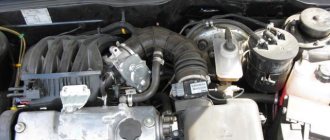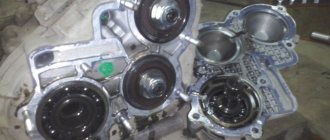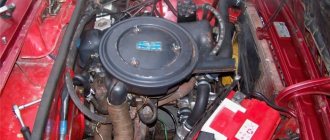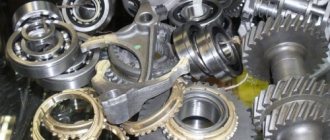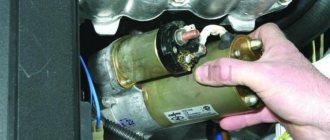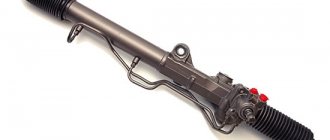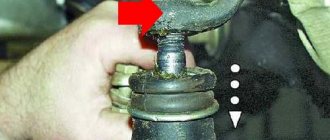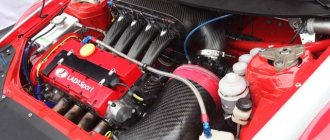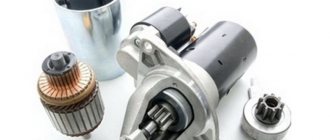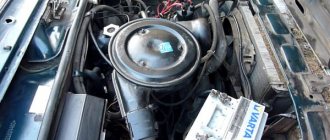Engine of the Eye
The Oka was created as a people's car, designed to satisfy the demand not only of young people, but also to fill the existing niche of transport and mobility vehicles for people with disabilities.
Based on the technical requirements and the assignment put forward to the designers, the entire car, and in particular the power unit, had to be made from widely used components and be able to carry out maintenance and repairs with one’s own hands without involving the qualified services of a certified service station.
The history of the development of the Oka family of cars has seen the use of various power units. Initially, during “prototyping” the original Daihatsu Cuore AB series engine was installed on the car, which had 2 cylinders and developed a power of 26-30 hp. The first few vehicles were produced for testing.
Despite the fact that the engine design was completely worked out by Toyota designers, this engine was not copied by Soviet designers, since the analysis of the design revealed increased requirements for the quality of parts and assembly of the engine itself.
In addition, the installation of such a power unit would require a complete production of engines from “0”, which would affect the final cost of the car and the timing of the car’s production.
By the time the concept of a “youth” or “people’s” car was approved, a VAZ 2108 car was delivered to the assembly line of the Togliatti automobile plant, which determined the fate of the power unit for the baby.
By 1979, VAZ power unit designers had fully developed the 2108 engine and were ready to move on to changing the line of 1.1 liter export VAZ 2108-1 engines to the 1300 cc 2108 engine, which was going to the domestic market. Therefore, it was decided to develop its own 2-cylinder engine based on a new power unit, which formed the basis of VAZ’s production line.
Features of engine maintenance and repair
Any power plant, including the one installed on the VAZ-1113, requires periodic maintenance, and after operating a certain number of engine hours, a major engine overhaul may be necessary. This type of repair is performed when the elements of the crank mechanism of the cylinder-piston group are severely worn. Note that the designers calculated a certain “life” resource of the motor, after which it is necessary to do a major overhaul, but it is significantly reduced due to the operating characteristics of the unit, the frequency of maintenance, the use of cheap technical fluids and low-quality filters.
Repair of the Oka car engine in most cases is carried out without removing it from the body. In some cases, some components and systems are removed from the vehicle for repair or replacement. Such components include power supply, cooling, starting, electrical supply and gas distribution systems.
Removal of the motor and subsequent disassembly is necessary only when performing repairs (replacement) of the crank mechanism (CPM), cylinder-piston group (CPG), as well as the shaft balancing system. It is worth noting that such a system is a design feature of the Oka two-cylinder engine. The thing is that in this engine the pistons move in pairs, and not as in other engines - separately. However, the power strokes in the cylinders are not synchronous. For example, both pistons rise up, but in one cylinder the compression stroke is performed, and in the second - the exhaust stroke. Further, after the pistons pass TDC, the power stroke is observed in one cylinder, and the intake stroke is observed in the second, and so on, in a circle. The balancing system available in this engine prevents the appearance of additional vibrations, which necessarily arise during such synchronous operation of the piston group cylinders.
The engine is “overhauled” when the unit has exhausted its working life or after a serious breakdown of the crank mechanism. As already written above, such work is performed only on a unit that has been removed from the car. Next, we propose to consider the process of independently removing the power plant from the engine compartment of the Oka car.
It is immediately worth noting that such a car engine can be removed in several ways. So, the key element of one of the methods is a lifting mechanism (for example, a hoist) - in this case, the engine is reached through the top. We will look at the process of removing the unit, lowering it through the bottom of the car.
To carry out dismantling work you will need the following tools and equipment:
Engine VAZ 1111
Oka engine 650 cc. turned out from half of the 2108 power unit. The choice of exactly half of the already developed block and the engine itself was determined by the cost of developing equipment for the manufacture of a 2-cylinder engine. A design feature of this in-line petrol twin is the overhead camshaft, which controls the operation of four valves - 2 for each cylinder.
The working process in the engine occurs in two revolutions of the crankshaft, which causes vibrations during operation of the internal combustion engine. To compensate for the imbalance, two balancing shafts are installed to dampen vibration. Engine power is 29 hp. The maximum torque is 44.1 Nm, which is achieved at 3400 rpm.
The fuel supply system is made according to the Euro-0 standard based on a carburetor. The fuel pump is mechanically driven by engine components.
The oil system is similar to the original 2108 using a gear pump. Oil is taken from the crankcase and sent through internal channels directly to the rubbing pairs of the camshaft and crankshaft.
The cylinder walls are lubricated by oil mist generated when the crankshaft rotates. The valve stems and parts of the valve timing mechanism, with the exception of the camshaft itself, are lubricated by gravity.
VAZ 1111 engine - features and design
The 650 cc engine 1111 is “half” of the 2108 engine. To create it, they simply took half of the engine and cylinder block, since it was easier and cheaper to develop equipment for such a solution than for a new unit. Thus, the 1111th is a two-cylinder in-line petrol carburetor engine, with 2 valves per cylinder and an overhead camshaft configuration.
1111 assembled:
Main characteristics of the Oka engine:
volume – 649 cubic meters. cm.;
Weight and dimensions of the Oka engine:
- weight – 66.5 kg without gearbox and clutch;
- overall dimensions – 550*640*670 mm.
The entire working process takes place in two revolutions of the crankshaft, due to which the engine experiences severe vibration loads. To compensate for them, two balancing shafts are provided to reduce motor vibration.
Interesting: in the VAZ 1111 engine, the fuel pump is not electric, but mechanically driven from the engine.
The supply of the fuel mixture is controlled by the carburetor. The lubrication system, as in 2108, is created with the installation of a gear pump. Engine oil is taken from the crankcase and supplied to the friction pairs of the camshaft and crankshaft. The cylinders are irrigated with oil mist generated during the operation of the crankshaft, and the engine gas distribution mechanism and valve rods are lubricated by gravity.
Engine VAZ 11113
The Oka 11113 (VAZ 11113) engine appeared in the process of refining the VAZ 2108 power unit and bringing its working volume to 1500 hp. Again, a half solution was used. The engine blocks of both 650 and 750 cc volumes were absolutely identical in appearance. The changes affected the piston diameter, which was increased from 76 to 81 mm. The engine block has been modified in internal design.
The partitions between the cylinders were thinned and the additional combustion chamber cooling circuit was eliminated. The power unit has become more highly loaded in the temperature department. This shortcoming in the early stages led to jamming of the pistons, the formation of scuffing on the cylinder walls and other malfunctions arising due to insufficient cooling.
Due to the modifications, the 11113 engine became more powerful and already produced 35 hp. and 52 Nm of thrust. The engine remained carburetor and complied with Euro-0 environmental requirements.
Basic faults
The main malfunctions of the first 650 cc engines and engine 11113 include increased noise and vibration. Increased noise appears when the engine warms up and is caused by the presence of balancer shafts. The noise is considered normal, although it causes concern for car owners.
Burnt out cylinder head gasket. It is caused by inaccurate manufacturing of gaskets in factories and improper tightening of the cylinder head, which allows the gasket to be incompletely compressed. During repairs, reuse of this sealing element is not allowed. Mandatory replacement is required, in this case you should pay attention to the surface of the gasket and if scuffing is detected, you should not use it.
Difficulties in starting a hot 750 cm 3 engine are due to the fuel pump diaphragm and the layout of the engine compartment. Elevated operating temperatures of the engine block lead to the formation of fuel vapors in the cavities of the pump, and the unit is not intended for pumping a gaseous medium.
If a malfunction occurs on the highway, just place a dampened rag on the pump body. This will be enough to get to the base location and replace the diaphragm.
Loss of spark. The spark generation system in the cylinders is made according to a non-contact circuit using an ignition coil. The location of the coil allows water to enter when passing through puddles. This causes failure of the voltage boosting element and results in the inability to start the engine.
Cooling system. It has the same problems as all VAZ engines. Poor quality of the pump leads to its failure, which in due course leads to overheating of the engine. The same applies to the reliability of the thermostat. If problems arise, elements need to be replaced.
Failures of electronic sensors. They are caused by poor-quality electronics by Russian manufacturers, as well as poor assembly standards of power units, which allow for incomplete fixation of sensors on the motor housing.
Repair of the OKA engine can be performed in a garage if you have experience in servicing and repairing Russian-made internal combustion engines. With the exception of specific elements, engine repairs are carried out using components used for repairing VAZ 21083 and VAZ 21093 engines.
Auto-reactor
The Oka car, 3.2 m long, belonging to class A (urban mini-cars), has been occupying the lowest, or initial (as you prefer), line in the price list of domestic models for the second decade. Oka has been produced since 1988 without any significant changes at two plants: in Serpukhov (at SeAZ, part of AvtoVAZ OJSC) and in Naberezhnye Chelny (ZMA KamAZ). Until the mid-1990s, Oka was also produced in Tolyatti, but VAZ curtailed its production, retaining only the production of power units and some other components. As a result, the annual production volume of Oka reached the planned 50 thousand only in 2001. In 2002, KamAZ produced the 200 thousandth Oka, and SeAZ produced the 100 thousandth. Both enterprises assemble standard and disabled versions of the Oka (the latter are sold only through the social security system). SeAZ (VAZ)-11113-21 is intended for drivers who control the car only with their hands, and versions 11113-22 and 11113-23 are for disabled people who can also use one leg (left or right). Over the decade and a half of production, the Oka has not undergone significant changes, only in 1996, instead of the 650 cc 29-horsepower VAZ-1111 engine, a 750 cc VAZ-11113 with a power of 35 hp appeared, which improved dynamics and efficiency. The Oka engine, equipped with a balancing shaft, is a “half” of the 1.5-liter VAZ-21083 carburetor engine and is unified with it in piston group units. Part of the electrical equipment, etc., was unified with other VAZ models, for example, the radiator, faucet and heating system fittings were taken from the VAZ-2105. Over time, the Oka received seats with fabric inserts, headrests, doors with molded plastic upholstery, a removable trunk shelf, and a washer and heater on the rear door. In 2002, the car was equipped with inertial seat belts. The exterior of the Oka remains virtually unchanged, although even the main manufacturers (not to mention numerous tuning companies) offer plastic body kits for it and paint the body with metallic paint. The interior is refined with a modern instrument panel and fabric seat upholstery. The lack of modernization and increased production volumes of Oka made it possible to saturate the market and somewhat reduce the price of many previously scarce, and therefore relatively expensive, spare parts.
The growing popularity of the Oka is associated both with its relative cheapness and its adaptability to urban operating conditions. High traffic intensity, the appearance of traffic jams in many cities, rising prices for gasoline and an increase in transport and other taxes have led domestic motorists to realize the advantages of a mini-car. In addition to being economical, the Oka is distinguished by quite decent handling and cross-country ability even on snowy roads, despite small 12-inch wheels, as well as acceptable capacity: two adults can fit in the back seat, and with the seat folded in the trunk you can transport even “25- inch TV (without packaging). However, the Oka is not very suitable for regular trips with the whole family to the dacha or for tourism due to its insufficient “carrying capacity” and the presence of only two side doors. Its “Achilles heel,” in addition to constant assembly defects, was noise and vibration in the cabin. In addition, the passive safety of the baby Oka is far from perfect, and the service life of many components and parts is short, which leads to frequent and rather labor-intensive repairs (especially during intensive use). This is the price to pay for the availability of the car itself. For example, the service life of the Oka engine is approximately one and a half to two times less than that of “standard” VAZ models. A used Oka with a mileage of no more than 50 thousand km (corresponding to approximately 4-5 years of operation) is quite suitable as a first car for beginners or a second car in the family (for example, for trips from the entrance to the garage). Older cars typically require major overhauls, which cost no less than repairs on larger models.
Possible problems Engine: Capricious carburetor. Failure of the thermostat and water pump (after 15 thousand km). Burnout of engine exhaust valves (after 30 thousand km). Increased wear of valve guides (after 25 thousand km). Knock of textolite gears of balance shafts (after 30 thousand km). Crankshaft rear oil seal leaking.
Transmission:
Quick clutch failure (20-30 thousand km). Gear shift mechanism failures.
Chassis:
Wear of CV joints (after 25 thousand km). Rapid failure of the steering rack (35 thousand km). Increased wear of brake pads at the rear (over 25 thousand km). Jammed parking brake cable and rear brake cylinder. Cracks in shock absorber strut plates. Fatigue failure of rear suspension springs (after 40 thousand km). Weak wheel rims. Disturbed wheel alignment of the front wheels, tire wear.
Electrical equipment:
Short-lived starter. Failure of the fan switch sensor.
Body:
The windshield seal does not provide a tight seal. Sagging doors due to wear of hinges (10 thousand km). Destruction of welding seams (starting from 5 thousand km - “SeAZ”). Loose fit of glass seals in doors and side windows. Corrosion of the body floor due to damp carpet. Foci of corrosion along the thresholds and at the bottom of the doors (after 15 thousand km - “SeAZ”). Unreliable muffler mounting. Broken exhaust pipe. The heater is not working well and the faucet is leaking. Spontaneous loosening of the seat fastening nuts.
The entry was published on November 17, 2008 at 12:57 pm and posted in the Buying a Used Car section. You can read comments using the RSS feed. The discussion is closed, but you can send a trackback from your site.
Maintenance of Oka engines
The Oka engine of both the first and second generations is quite reliable. And if the factory requirements for maintenance regulations are met, it has a service life of 120,000 km.
According to the vehicle passport, both engine 11113 and engine 1111 have a maintenance program every 15,000 km. To undergo maintenance at this interval, it is recommended to use fully synthetic motor oil. When using semi-synthetics, and even more so mineral motor oils, the Oka engine requires changing the lubricant in accordance with the service life of the oil, that is, at least 10,000 km.
In this case, the oil system must be flushed and the filter element replaced. The oil volume in the Oka engine is 2.5 liters, but when replaced, 150-300 ml of lubricant remains on the engine walls, so the filling volume is controlled by the dipstick. Overfilling of oil is not allowed.
The OKA 11113 engine cooling system requires fluid replacement after operating 60,000 km. At the same time, the coolant retains its lubricating and anti-corrosion properties and prolongs the operation of the cooling system.
Every 30,000 km, mandatory valve adjustment is required. But in fact, the gaps are adjusted according to the technical condition with control at a given mileage.
Additional work that is not relevant on modern cars includes mandatory cleaning of the carburetor every 30,000 km with idle adjustment at each regular maintenance.
At 60,000 km, regardless of the technical condition, the timing belt is replaced. The design of the cylinder-piston group allows the valves to bend when the belt breaks, so this procedure should not be neglected.
Design and repair of the OKA 11113 engine
Typical breakdowns of the VAZ-1111
In general, the Oka car is a fairly reliable and unpretentious model: the car has low fuel consumption, a high-quality chassis that is perfectly adapted to our roads. However, during operation, certain technical problems appear with enviable regularity in various systems and mechanisms of the machine. We will tell you in more detail about the most common breakdowns and malfunctions.
Starter problems
Probably all VAZ-1111 owners are familiar with the situation when you turn the ignition key, but the car does not react at all - the starter does not even try to turn the crankshaft. How to find out what the problem is and what to do in such a situation? First, check the battery terminals: are they securely clamped, is there any oxide on them. Perhaps the “plus” or “minus” just disappeared. Secondly, it is necessary to prevent jamming of the crankshaft. To do this, rotate the coolant pump (pump) or the generator shaft. If they do not rotate, you should contact a service station; such a problem cannot be fixed on site. Third, inspect the ignition switch and starter - perhaps one of the contacts has become disconnected and therefore no electric current is supplied. Fourth, if you hear a crackling sound under the hood when you turn the ignition key, then most likely the starter traction relay has burned out. It needs to be replaced. Fifth, it is not uncommon for the starter to make a lot of noise when operating. A possible cause is incorrect installation of the starter or a loose fastening. Tighten loose bolts or align the entire mechanism. Sixth, strong noise is also possible due to wear of the bearing bushings. In this case, they should be replaced.
If the starter turns the crankshaft freely, but the engine still does not start, then do the following: • check the battery capacity, there may not be enough voltage. Most often in this case, a crash is heard. If so, recharge the battery or replace it; • check the Hall sensor using a voltmeter; if the required device is not at hand, then install a known-good sensor (experienced motorists recommend always carrying a spare Hall sensor with you); • the engine may not start due to a faulty switch. It cannot be repaired - it should be replaced immediately; • check that the ignition timing is set correctly; • make sure that the marks on the crankshaft and camshaft match.
If after this the car still does not start, then we proceed to checking the spark plugs: • unscrew the spark plugs and measure the gap (standard – 0.7-0.8 mm); • if there are spare working spark plugs, screw them in; it may be that the old ones have simply become unusable. Carburetor malfunctions
The second mechanism that may be causing the car to not start is the carburetor: • the needle valve may be stuck in the closed position - lightly tap the carburetor cover. Replace the faulty valve as soon as possible; • if there is no gasoline in the carburetor float chamber, then check the filters and pipes of the fuel system. They may be clogged or pinched; • in hot weather, especially after standing for a long time, gasoline may evaporate from the carburetor. Try manually pumping fuel; • the pump may be faulty - unscrew the fuel hose from the carburetor, clamp it with your finger and pump gasoline manually - a working pump will create noticeable pressure; • check the jets (main fuel and idle), maybe dirt has gotten into them; • tighten all carburetor bolts and fastenings.
Idle problems
There are situations when the VAZ-1111 engine does not run smoothly or often stalls. There are several reasons for such malfunctions: • the filter, fuel lines are clogged, or water has entered the gasoline - replace the filter or use a special fuel additive that dissolves water; • the idle speed may not be adjusted; • dirt has got into the jets (main and idle) - wash them with gasoline; if there is a thin needle, clean the channels; • if the engine does not start well or there are popping noises, then most likely there is insufficient fuel level in the float chamber. The float should be adjusted; • too high a fuel level in the carburetor can also cause the engine to run rough; • check the idle speed solenoid valve - often the terminal simply falls off due to vibration; • insufficient or excessive spark plug gap (recommended values – 0.7-0.8 mm). Low idle speed can be the result of the following malfunctions: low or excessively high fuel level in the float chamber; • insufficient engine warm-up; • loose jets; • clogged air and fuel filters. High speeds are most often due to incorrect idle speed adjustment, incorrectly set ignition angle, or a faulty throttle valve.
"Shots" from the exhaust pipe
Each of us has heard more than once how a literal cannonade sounds from the exhaust pipe. The VAZ-1111 car is also susceptible to a similar disease. The reasons for this are the following: • incorrectly set ignition timing angle; • the switch is faulty; • the valve timing is off – the marks on the crankshaft and camshaft do not match; • the ignition coil is broken; • spark plugs with an inappropriate heat rating are installed
The smell of gasoline
Often, domestically produced cars “delight” the driver and passengers with a persistent smell of gasoline. If this situation is familiar to you, then proceed according to the following algorithm: • check the threaded fasteners and clamps on the fuel system hoses; • inspect the oil dipstick; if there are traces of gasoline on it, then gasoline may enter the engine crankcase through a faulty fuel pump diaphragm. You need a diaphragm or a pump; if a lot of fuel gets in, then so does the oil; • adjust the carburetor starter; • check the gasoline level in the float chamber; • tighten the fuel jets tightly; • adjust the ignition timing; • inspect the throttle valve, it may be stuck; • use a compressor to check the pressure in the cylinders. The smell of gasoline can be caused by wear of valves, rings, seats and other elements.
Increased fuel consumption
If your car has increased fuel consumption, then it is necessary to check the following components and mechanisms: • fuel pump diaphragm - its damage leads to gasoline getting into the engine crankcase; • tighten all clamps and threaded connections of the fuel system; there may be a leak at some junction; • Quite often, increased resistance to vehicle movement causes excessive fuel consumption. A VAZ-1111 at a speed of 50 km/h should have a run-out (i.e., the distance that the car will cover with the neutral gear engaged) of more than 500 m; if this does not happen, then check the tire pressure, the angles of the front wheels and the operation of the brake system (perhaps it is jammed); • adjust the carburetor, check the throttle valve, jets, needle valve; • Sometimes increased fuel consumption is a sign of worn or damaged valves and piston rings.
Increased oil consumption
Increased oil consumption is considered to be 500 g per 1000 km, i.e. if you have to add oil to your engine every few hundred kilometers. The reasons for this malfunction are the following: • wear of the sealing edges, hardening of the gaskets. In this case, you should wash the engine and after a short drive find the location of the leak; • clogged crankcase ventilation system; • wear or loss of elasticity of oil seals (valve seals), valve stems or guide bushings. It will be necessary to partially disassemble the cylinder head and replace broken parts; • wear or breakage of piston cylinders and their rings. It is difficult to replace cylinders on your own without special equipment, so it is better to contact a service station.
The oil pressure warning light is on
If your oil pressure warning light comes on while driving, you should stop immediately. Further driving may result in serious engine damage. After stopping, carry out the following diagnostics: • check the oil level on the dipstick; • it is possible that oil of inappropriate viscosity has been filled in – replace it; • remove the oil pan and check the oil receiver mesh (may be clogged) and the pressure relief valve for distortion, clogging or weakening of the spring; • inspect the fuel pump diaphragm - if it is damaged, gasoline enters the oil, thereby diluting it; • check the oil pump - it may be faulty due to wear on the gears; • make sure that the emergency oil pressure sensor is working properly and the terminal is connected to it (the contact may have fallen out).
Tuning and modification of Oka engines
Tuning the Oka engine does not make practical sense under normal operating conditions. Increasing power and torque when flashing ECM units can give an increase of up to 10% horsepower, which is about 30 hp. will not be particularly practical.
As a garage modification, Oka engine tuning is performed by installing an injector from a VAZ 21083i, but the cost of modification can be comparable to installing a Chinese liter TJ376QE FAW engine (Daihatsu), which was mounted on a Serpukhov-made SeAZ Oka 11116-02 car in 2007-08.
Other small-scale Oka power units
Only VAZ 1111 and VAZ 11113 engines were serially installed on the car. It was with these power units that the car was supplied to retail chains.
As options to save production and meet environmental requirements, both SeAZ and KAMAZ tried to use power units from other manufacturers. This was due to the fact that AvtoVAZ refused to continue producing minicars and actually stopped supplying power units to complete the car.
So in 2004, a trial series of cars with a Korean Hyundai Atos engine was produced. 15 cars were produced for trial testing, but the program did not go into series.
Also this year, small-scale tests were carried out at SeAZ of cars with engines from the Melitopol plant MeMZ 245. The car was called OKA-Astro and was subsequently produced in small series at the Kamov automobile assembly plant. Another version of the Ukrainian power unit was MeMZ 247.1. This engine, which complied with Euro-2 requirements, was not supplied for mass production, although such equipment is rarely found on the secondary market.
In 2007-2008, a Chinese three-cylinder injection engine was installed at the Serpukhov plant, which developed 53 hp.
The sports version of the Oka uses the engine from Priora.
The Oka-based tracked all-terrain vehicle uses a VAZ 2131 engine.
As an option for garage tuning, there are several examples of cars using three-cylinder Volkswagen diesel engines.
Source
Powerplant removal method
The sequence of work is as follows:
5. Remove the high-voltage wires (from the spark plugs and coil);
6. Disconnect the wiring going to the spark torque sensor;
7. Loosen the clamp securing the gasoline supply pipe to the gasoline pump and remove it;
9. Loosen the clamps and remove the pipes from the thermostat housing that go to the cooling radiator;
10. Remove the pipes leading to the interior heater;
11. Loosen and disconnect the clutch cable;
12. From the gearbox, disconnect the speedometer drive, the wire of the sensor for turning on the reverse signal, as well as the ground wire put on the stud of the gearbox housing;
13. Disconnect the wiring from the starter and generator;
14. Under the car, loosen the tie clamp at the entry point of the exhaust pipe coming from the manifold into the receiving pipe of the resonator. We move the resonator back, disconnecting the connection;
15. Disconnect the wire leading to the oil pressure sensor;
16. Disconnect the gearshift lever rod leading to the gearbox;
17. Remove the front wheels, unscrew the nuts of the outer CV joint shafts, and pull the hubs off them;
18. Unscrew the bolts securing the steering gear brackets to the subframe;
19. We place the prepared bars under the subframe, after which we carefully lower the jacks, ensuring that the subframe, together with the engine, rests on these bars;
20. Unscrew the bolts securing the subframe to the body;
After this, it is checked whether everything is disconnected, and then, with an assistant, the front end simply rises up (without the motor - it is not heavy) and the body rolls back, and the motor, together with the gearbox, the drive and the subframe, remains lying on the bars.
Well, then further disassembly is carried out, the worn components are rebuilt (for example, replacing the Oka crankshaft), and then the engine is assembled. After the VAZ-11113 engine has been repaired, it is reinstalled in place, for which everything must be done in the reverse order.
Technical characteristics of the Oka engine
The Oka engine in the car of the same name is the smallest of all engines. The vehicle was equipped with domestic and Chinese power units. But the latter were installed on the car model that came off the Chinese production line. Since there were three modifications of cars called OKA: these are the 1111 and 11113 series. The 16th series was created at a factory in China.
"Oka"-11116
At the last stage of production, the small car began to be equipped with a Chinese-made power unit, which somewhat “revitalized” the car, but did not save it from curtailing production.
The Chinese installation was three-cylinder, with a total volume of 1.0 liters. Its power rating was 53 hp. With. This motor was already equipped with an injection power system.
Also, Oka with this engine received a 5-speed. Manual transmission.
How to disassemble a VAZ Oka engine
Technical characteristics of the Oka engine
Engines 11113 Oka had a volume of 0.6, 0.7 and 1 liter. The power of the power units started from 30 horsepower and ended at 53 horsepower. However, the weight of the car itself did not require the installation of a large engine. The vehicle is compact and small in size. Suitable for purchase by young people, if there is no finance for a more powerful car, and by people with disabilities.
Now let's look at the technical characteristics of the engine from the OKA car. They are given in the table below.
| Characteristic | Designation |
| Modification | VAZ 1111 |
| Engine type | Four-stroke, carburetor |
| How the cylinders are arranged | In a row |
| Diameter of one of the cylinders in mm | 76 |
| Piston stroke in the device | 71 mm |
| Total motor capacity | 649 cc |
| Compression | 9,9 |
| Power | 29.3 horsepower |
| Ignition | Contactless |
| Fuel type | AI 92 or AI 95 |
| Weight | 63 kg |
| Fuel consumption in combined driving cycle | 3.9 l |
| Oil volume | 2 l |
| Ecoclass | Euro 0 |
Attention! There are other models of the Eye engine, the characteristics of which will be different. For example, the appearance of the power units of the VAZ 1111 and VAZ11113 is the same. But the cylinder diameter was increased to 81 mm, and an additional cooling system was installed. The manufacturer has increased the thickness of the walls between the cylinders.
Sequencing
Let's move on directly to the process of replacing piston rings on a VAZ Oka without removing the engine (key points are shown in the photo). Everything is done like this:
5. Remove the protective cover of the timing drive, loosen the drive roller, and remove the belt from the camshaft gear. We unscrew the bolt of this wheel and remove it from the shaft (carefully so as not to lose the key);
6. Disconnect the pipes from the valve cover, unscrew the bolts securing it and remove it from the car;
7. Disconnect the vacuum regulator pipe;
8. Unscrew the bolts securing the spark torque sensor and move it to the side;
9. Unscrew the fuel pump and put it aside;
10. Unscrew the fastening of the spark torque sensor drive housing and remove it;
11. Unscrew the upper bolt securing the rear timing belt cover and move it to the side;
12. Unscrew the nuts securing the camshaft bearing housing and remove it;
13. Carefully dismantle the camshaft along with the oil seal. When assembling, it is better to replace the Oka camshaft oil seal. If you are only replacing the camshaft on the Oka, further disassembly is not necessary;
14. Remove the generator mounting bracket;
15. Remove the tension roller;
16. Disconnect the cooling system pipelines leading to the cooling jacket;
17. Disconnect the wire of the coolant temperature sensor;
18. Unscrew the nuts securing the exhaust pipes from the head, then carefully remove them from the studs;
19. Unscrew the head mounting bolts. In this case, you need to follow the correct sequence of their relaxation. Remove the bolts;
20. Carefully remove the head along with the intake manifold and carburetor.
This concludes the disassembly in the engine compartment. The rest is done under the car. To remove the pistons, you must:
After replacing the rings, using a special device for seating the pistons, we put them in place, trying to immediately guide and place the connecting rods correctly (you can ask an assistant to guide them from below). And then all the removed elements are simply installed in place.
Fuel consumption
Fuel consumption in the Oka engine is the lowest compared to other vehicle engines. In mixed mode it is a little more than three and a half liters per 100 kilometers, and when driving on the highway there is no more than three rubles.
When driving around the city with frequent stops, intersections, pedestrian paths, where you need to stop and let people pass, wait until the light turns green, fuel consumption increases to 4 liters per hundred kilometers.
Attention! There is no point in tuning the engine to increase power. The maximum increase in power after reflashing the engine brain can be ten percent. For 30 horsepower, 10 percent is not advisable.
Disadvantages, breakdowns and engine problems
The disadvantages of the Oka power unit include the following malfunctions:
The camshaft and crankshaft are more reliable. Although they sometimes fail. The main thing is to observe the maintenance time.
Service is carried out every fifteen thousand kilometers. During the passage of To, the oil is changed, mostly synthetic is used. Because it is more reliable. If semi-synthetics were poured into the power unit, then the lubricant is changed after 8 thousand kilometers. Since it quickly loses its properties, unlike synthetics.
After 50 thousand kilometers it is necessary to replace the coolant. And valve clearances need to be adjusted every 30 thousand kilometers.
Sequence of actions when replacing piston rings
Next, we propose to move on to the direct process of replacing the rings on the Oka car engine without removing it from the engine compartment. This is done this way:
The process of disassembling the engine in the engine compartment after removing the head can be considered complete. The remaining actions are performed under the car. In order to get the pistons you need:
After replacing the piston rings, you need to install the pistons in their place. To do this, you should use a special device. All other steps for assembling the engine are performed strictly in the reverse order.
As you can see, there are quite a lot of operations to remove the engine and replace piston rings, but they are not all that complicated, so it’s quite possible to do this work with your own hands in one day.
I decided to do the overhaul after completely disassembling the engine and inspecting it. But alas, not immediately after the purchase, but only after more than a year of its operation - there was no money and I finished it off (not on purpose, but because I didn’t pull at the bottom at all) by often spinning it up to 5-6 thousand rpm on the 21081 carburetor Before purchasing the car, a poor-quality repair was made (boring into the first repair one without replacing it with a corresponding piston), as a result of which the engine also died very quickly, and a burnt-out exhaust valve was discovered in the second cylinder. The overhaul was carried out in Naberezhnye-Chelny in the QUASAR Workshop. What was done:
1. Boring to 82.8 2. Connecting rods and pistons 2110 with a floating pin 3. Piston cooling nozzles 4. Light valves 5. Bronze guides 6. RS pusher washers 7. Drilled channels for forced lubrication of pushers 8. Grinding of the elbow, all gaskets, new cylinder head bolts etc. 9. Kraft clutch, grooving the flywheel and replacing its crown.
You can see the finished motor in the photographs. After running in 3000 km, it began to pull much stronger, unlike the new state, not a drop of oil leaks anymore, the engine is dry and clean!))))
The gearbox was disassembled and washed. The gears turned out to be in good condition, and the entire series, apparently it was simply replaced as an assembly at some point. I also installed a driveshaft from Kalina. Summer oil was poured into the engine and into the Shell gearbox.
First steps when repairing a car. Assembling the VAZ-11113 (Oka) cylinder block is one of the steps in engine overhaul.
The video shows a major overhaul of a VAZ Oka engine. Many car owners come to such repairs, whose car mileage is well over a couple of hundred thousand km.
An engine overhaul is a complete restoration of the engine's performance. Occurs by way of repair
It is also possible to completely replace all of the above parts.
How to overhaul a VAZ Oka engine? It's very simple, just read these instructions.
The success of this entire event directly depends on the characteristics of the parts and the experience of the craftsman performing the work. Also, do not neglect technical literature. After all, all engine models have their own characteristics and assembly rules.
The main prerequisites for overhaul are the appearance of knocking noises when the engine is running, or, in the worst case, its complete jamming. The reason for this is wear of the plain bearings, crankshaft journals, and rotation of the liners. If the engine is heavily worn, excessive oil consumption, blue smoke from the exhaust pipe, and coking of the oil scraper piston rings are possible. All this is a consequence of burnt-out valves and cylinder head gaskets. This can be monitored by measuring compression with a compression meter. Cavities on the surface of the piston can be identified using an endoscope.
The decision to carry out major repairs is made after troubleshooting. To do this, all runouts and gaps are measured with a micrometer. But there are cases when troubleshooting may not be necessary - this is the case of engine jamming due to a broken connecting rod, destruction of the pistons, etc.
The main stages of engine overhaul
Each step has its own characteristics. For example, when dismantling, the main thing is to follow a certain sequence so as not to damage anything. And when washing an engine, for example, you need to do it very carefully, because any measurements on a dirty engine will be incorrect.
If you decide to do the overhaul yourself, then just follow the instructions for your motor and be careful.
Fortune on the roads and all the best.
general description
The VAZ-1111 engine is an in-line, two-cylinder, transversely mounted. Thanks to this arrangement, the engine compartment turned out to be compact, which made it possible to reduce the overall dimensions of the car. The engine received a liquid cooling system with forced circulation, a carburetor power supply system and an electronic ignition system.
Model 11113 has the same design of the power unit. The difference between the engines of these modifications is the basis. Version 1111 is, in fact, “half” of the 1.3-liter VAZ-2108 unit, and 11113 is a 1.5-liter engine of the same G8. Because of this, the engines have different engine displacement and power.
The power plant is fixed in the engine compartment on a special subframe. The manufacturer did not provide protection for the Oka engine.
Despite the fact that the installation was based on a 4-cylinder engine, the Oka unit has one very interesting feature - synchronous stroke of the pistons. If you look at the Oka engine in cross-section, the pistons are located at the same level and “walk” together, but the cylinders function separately.
The operating principle of an engine with this design feature is quite simple - the strokes in the cylinders are offset. That is, if the compression stroke occurs in the 1st cylinder, then the exhaust stroke occurs in the 2nd cylinder. And so on for all strokes, so the cylinders in this engine work alternately.
Cylinder block
The power plant crankcase is made of cast iron. As on all VAZ models, the cylinders are not inserted, but bored into the block. The cooling system channels (the so-called “jacket”) run throughout the block.
Since the power unit is a two-cylinder, in-line, there are only three supports for the crankshaft main journals at the bottom of the block. During the production process, high-precision machining of the working surfaces of these supports is carried out simultaneously with the covers.
As a result, each support has its own cover and they cannot be swapped, otherwise the crankshaft may rupture during operation of the car. To eliminate the possibility of installing the cover in the wrong place when repairing the power unit, they are marked.
The cylinder head is solid cast aluminum. Since the engine has a timing belt with an overhead camshaft, the cylinder head is equipped with beds for the shaft. To install the camshaft, three beds with covers were made. There are no shaft bearings; their role is played by the working surfaces of the bed and cover (therefore, if the bearings are heavily worn, the entire head must be replaced).
The cylinder head also houses timing valves (2 for each cylinder). As usual, the intake valve, to ensure better filling of the cylinder with the combustible mixture, has a larger diameter than the exhaust valve.
The cylinder head is fixed to the block with 6 bolts. When tightening fasteners, a certain pattern is used, which eliminates the possibility of the head being “skewed.”
Bolts require gradual tightening with increasing tightening torque. The force on the cylinder head mounting bolts has strictly defined values, so tightening must be done with a torque wrench.
The camshaft is made of cast iron, has a high degree of processing of the working surfaces - bearing journals and cams. In addition to acting on the valves, the camshaft also drives the vacuum fuel pump, for which there is an eccentric on the rear of it.
Thermal clearances on Oka engines are adjusted using special washers installed between the camshaft cams and valves.
The crankshaft is a magnesium cast iron casting with subsequent high-precision machining of the working surfaces. It has 3 main journals and 2 connecting rods. 4 shaft cheeks, located between the journals, act as counterweights that reduce motor vibration during operation. The working surfaces of the crankshaft are lubricated through oil channels made inside the shaft.
In the front part of the crankshaft there are seats for the timing gear and the generator drive pulley. At the rear, in addition to the flange for attaching the flywheel, there is a balance shaft gear.
The flywheel is cast from cast iron, the gear rim is mounted “hot” on it.
A special feature of the flywheel is the ability to “flip” it. That is, if the ring is heavily worn on one side, the flywheel can be turned over to start using the unworn part of the teeth.
The friction bearings of the main and connecting rod journals are made of soft tin-containing alloys. The supporting elements of the main journals have special grooves on the working surface for supplying lubricant. For proper installation of bearings, there are special notches on their edges.
Balancer shafts are designed to reduce vibration of the power plant (and it vibrates significantly due to the synchronous stroke of the pistons). They consist of two shafts installed parallel to the crankshaft and interacting with it through gears.
It is noteworthy that the gears are not made of metal, but of textolite or plastic. Since these gears do not experience any special load during operation, they do not require special strength. In addition, the use of textolite and plastic made it possible to reduce the overall weight of the power unit.
The lower connecting rod heads, like the crankshaft supports, are processed together with the caps. To avoid mixing up the covers during assembly and installing them incorrectly, there are marks.
Cylinder-piston group
The piston is made of heat-resistant aluminum alloy; the part is subjected to additional heat treatment during the manufacturing process.
The piston bottom is flat (which makes the engine “plug-in”), but it is possible to install pistons from a VAZ-2108 with grooves on the bottom for the valves.
Number of rings – 3. The top two are compression, the 3rd is oil scraper. A hole is made in the groove for the oil scraper ring to drain the lubricant removed from the cylinder walls.
Compression rings ensure sealing of the combustion chamber (the necessary compression is created in the cylinders). Additionally, they participate in heat exchange - they remove heat from the top of the piston and transfer it to the cylinder walls. The oil scraper ring is equipped with a radial expander to increase the area of contact with the walls.
The finger is a round piece, hollow. The finger is “floating”, that is, during operation it rotates in the bosses.
How to choose rings and pistons
Let's go through how to choose replacement rings. Everything is relatively simple here. When creating this engine, the designers tried to unify it as much as possible with another, namely the VAZ-2108. Therefore, the dimensions of the Oka pistons are completely identical to the Vosmerov pistons, only their number is different. In this case, you should focus on the engine size. To modify the VAZ-1111 with a 0.65-liter engine, rings from a 1.3-liter engine are suitable, since the piston diameter of the Oka and the V8 are identical. The same applies to another model - VAZ-1113 with a 750 cc engine. cm. Rings and pistons from a 1.5-liter engine of the same VAZ-2108 are suitable for it.
When selecting, you should also take into account that when replacing, pistons and rings of repair sizes are used. In addition, configurations of the same rings specifically for Oka are practically not found, so you will have to purchase a complete set for the VAZ-2108, but use only half of it.
Differences, technical indicators
A little about how domestically produced Oka engines differ regarding the device. In general, their general design is identical. The only difference is:
As for the operating parameters, they are given below:
| Characteristics of Oka power units 1111 and 11113 | |||
| Parameter | "Oka" 1111 | "Oka" 11113 | "Oka" 11116 |
| Engine displacement | 649 cc cm. | 750 cc cm. | 993 cc |
| Engine power | 29.3 l. With. | 33 hp | 53 hp |
| Torque | 44 Nm | 50 Nm | 77 Nm |
| Engine compression | 9,9 | 9,9 | 9,9 |
| Cooling system type, volume | Liquid, 4.8 l | Liquid, 4.8 l | Liquid, 4.8 l |
| Type of lubrication system, oil volume | Combined, 2.5 l | Combined, 2.5 l | Combined, 2.5 l |
| Power system type | carburetor | carburetor | carburetor |
| Ignition system type | electronic | electronic | electronic |
All modifications of the Oka power plant were coupled exclusively with a 4-speed manual transmission.
